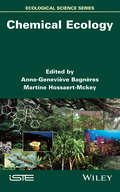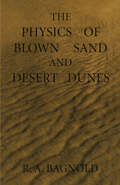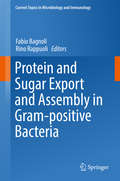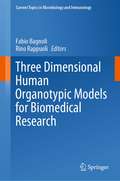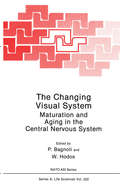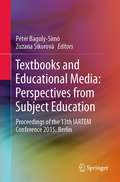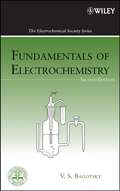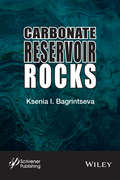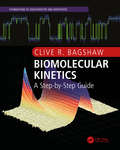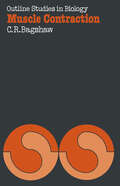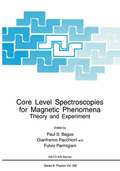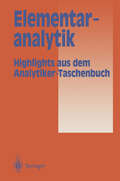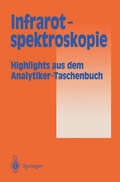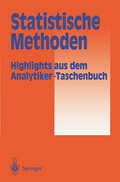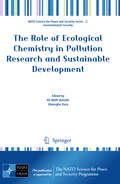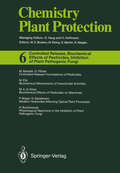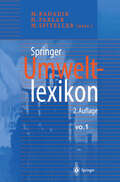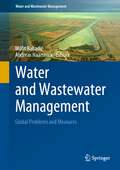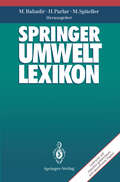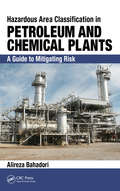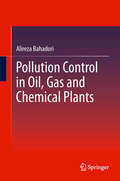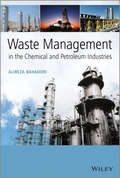- Table View
- List View
Chemical Ecology: New Advances
by Anne-Geneviève Bagnères Martine Hossaert-McKeyThe book features comparative perspectives on the field of chemical ecology, present and future, offered by scientists from a wide variety of disciplines. The scientists contributing to this book –biologists, ecologists, biochemists, chemists, biostatisticians – are interested in marine, freshwater and terrestrial ecosystems and work on life forms ranging from micro-organisms to mammals, including humans, living in areas from the tropics to polar regions. Here, they cross their analyses of the present state of chemical ecology and its perspectives for the future. Those presented here include complex, multispecies communities and cover a wide range both of organisms and of the types of molecules that mediate the interactions between them. Up to now, no book has presented a solid scientific treatment of a wide range of examples. This book illustrates a diverse panel of the most advanced aspects of this rapidly expanding field.
The Modern Bestiary: A Curated Collection of Wondrous Creatures
by Joanna Bagniewska'An illuminating compendium of some weird and wonderful creatures.' ObserverFrom the familiar to the improbable, the gross to the endearing, The Modern Bestiary is a compendium of curious creatures. It includes both animals that have made headlines and those you've probably never heard of, such as skin-eating caecilians, harp sponges, or zombie worms - also known as bone-eating snot flowers. Arranged by elements (Earth, Water, Air), The Modern Bestiary contains well-known species told from new, unexpected angles (rats that drive cars; fish that communicate by passing wind), as well as stranger and lesser-known creatures, including carnivorous mice that howl at the moon, cross-dressing cuttlefish, and antechinuses - small marsupials that literally mate themselves to death. Finally, there are the 'aliens on Earth' - the incredible, the surreal, the magical - such as tardigrades, tongue-eating lice and immortal jellyfish, creatures so astonishing that they make unicorns look rather commonplace.Written by a zoologist with a flair for storytelling, this is a fascinating celebration of the animal kingdom.' [A] beautifully written book to make you laugh, squirm and - perhaps most importantly - appreciate how lucky we are to not have to live inside an anus.' Yussef Rafik'The Modern Bestiary provides a fascinating, accessible and humorous insight into the wonders of the natural world.' Amy Dickman, director of Oxford University's Wildlife Conservation Research Unit 'If you love animals, especially ones with unsavoury habits, this book is for you. Entries are crafted with affection, cast-iron scholarship and an unyielding dedication to exposing as much hilarious weirdness as the animal kingdom can offer.' Tom Moorhouse, author of Elegy for a River'Everyone who loves wildlife - especially fantastically weird and cringingly gross wildlife - should read this masterful book.' Mark Carwardine, author/presenter of Last Chance to See'If ever there was a book that highlighted the bewildering wonders of the natural world, and the need for their conservation, this is it.' Michael Brooke, author of Far from Land
The Physics of Blown Sand and Desert Dunes
by Ralph BagnoldTHE NATURE OF THE PROBLEM THIS book results from an attempt to explain on a basis of experimental physics some of the many strange phenomena produced by the natural movement of sand over the dry land of the Earth. The subject is but one aspect of a far wider problem which is still very imperfectly grasped-the transport of solid particles of any kind by fluids in general. Here the difficulty has been, and still is, that no one branch of science has attempted to deal with the problem as a whole, or to co-ordinate the vast amount of piecemeal work by students of different outlook in many unrelated fields. The carriage of silt by rivers has received a great deal of attention from engineers. But owing to the difficulties of direct measurement, to the expense and labour of conducting full-scale experiments, and to a failure to find agreement as to the basic quantities upon which a theoretical edifice may be built, the published results are far from satisfactory. Little has emerged except empirical formulae; and these are rarely capable of reliable application to conditions other than those under which they were evolved. The drifting of snow is of direct interest to transport authorities in many countries, to meteorologists engaged in the study of rainfall, to ski-runners and to mountaineers. Yet no means has been found whereby the precipitation can be gauged, or the rate of drift related to the strength of the wind.
Protein and Sugar Export and Assembly in Gram-positive Bacteria (Current Topics in Microbiology and Immunology #404)
by Fabio Bagnoli Rino RappuoliThis book focuses on the envelope of Gram-positive bacteria including its composition, the latest discoveries in the mechanisms behind its assembly, and its role in pathogenesis. Furthermore, new applications in biotechnology and vaccine development involving these bacteria are discussed in detail. This concise volume consists of eleven chapters by prominent experts in the field, which review the latest findings and current state of knowledge on a range of diverse yet interlinked aspects. This book is written for all researchers, clinicians and technicians engaged in basic or applied science projects on Gram-positive bacteria.
Three Dimensional Human Organotypic Models for Biomedical Research (Current Topics in Microbiology and Immunology #430)
by Fabio Bagnoli Rino RappuoliThis edited volume discusses the application of very diverse human organotypic models in major areas of biomedical research. The authors lay a main focus on infectious diseases, cancer, allergies, as well as drug/vaccine discovery and toxicology studies. Representing a valid alternative to laboratory animals, these models are relevant for most areas of translational research. As the contemporary research shows, many human tissues can today be cultivated in vitro and used for several research objectives. This book provides an unprecedented overview of recent developments in an exciting field of research methodology. It is a reference guide for scientists in both academia and industry. Readers can update their knowledge and get hands-on recommendations on how to set up an organotypic model in their lab. Chapters 'Progress on Reconstructed Human Skin Models for Allergy Research and Identifying Contact Sensitizers' and 'Human Organotypic Models for Anti-infective Research' of this book are available open access under a CC BY 4.0 license at link.springer.com.
The Changing Visual System: Maturation and Aging in the Central Nervous System (Nato Science Series A: #222)
by P. Bagnoli W. HodosIn late May and early June 1991, a NATO Advanced Study Institute was held at a hotel in the hilltop village of San Martino al Cimino a few kilometers from the city of Viterbo in the Lazio region of Italy. The title of the course was the same as this volume and brought together specialists working at all phases of the life span (embryology, infancy, childhood, middle life and senescence) in both animals and humans to exchange ideas, facts and theories in the search for common principles. Such principles could prove important for understanding developmental changes in the central nervous system and visual behavior within the context of a continuum of life-span processes rather than viewing them as events or mechanisms that occur only in a certain period. For example, changes that are associated with "aging" were considered as extensions or continuations of processes that began at an earlier stage of the life span, rather than being seen as processes that only began late in life.
Textbooks and Educational Media: Proceedings of the 13th IARTEM Conference 2015, Berlin
by Péter Bagoly-Simó Zuzana SikorováThis book brings together empirical research and conceptual work on textbooks and education media from 13 countries and 17 disciplines. Along with textbook production, usage, and development, it also explores the interconnectedness of (educational) policy and teaching and learning materials. Further, the book offers insights into regional and local discourses (e.g. specific theories of Portuguese- and Spanish-speaking countries as well as Nordic countries, contrasting their theories with international literature), practices, and solutions with regard to teaching selected subjects at the pre-primary, primary, secondary, and tertiary level. This book also discusses the specific combinations of subjects (e.g. Physics, Biology, Geography, Swedish, English) and their subject-specific education (e.g. Physics Education or Didactics). Lastly, it examines the work of a number of early-career researchers, giving them a voice and bringing in fresh ideas currently being developed in various countries around the globe.This proceedings volume will appeal to publishers, subject educators in primary, secondary, and tertiary education, and academic researchers from the fields of textbooks, educational media and subject-specific education. Its international authorship and explicit focus on subject-specific particularities of educational media provide a unique and comprehensive overview.
Fundamentals of Electrochemistry (The ECS Series of Texts and Monographs #44)
by Vladimir S. BagotskyFundamentals of Electrochemistry provides the basic outline of most topics of theoretical and applied electrochemistry for students not yet familiar with this field, as well as an outline of recent and advanced developments in electrochemistry for people who are already dealing with electrochemical problems. The content of this edition is arranged so that all basic information is contained in the first part of the book, which is now rewritten and simplified in order to make it more accessible and used as a textbook for undergraduate students. More advanced topics, of interest for postgraduate levels, come in the subsequent parts. This updated second edition focuses on experimental techniques, including a comprehensive chapter on physical methods for the investigation of electrode surfaces. New chapters deal with recent trends in electrochemistry, including nano- and micro-electrochemistry, solid-state electrochemistry, and electrocatalysis. In addition, the authors take into account the worldwide renewal of interest for the problem of fuel cells and include chapters on batteries, fuel cells, and double layer capacitors.
Carbonate Reservoir Rocks
by Ksenia I. BagrintsevaMost of the world’s energy still comes from fossil fuels, and there are still many strides being made in the efficiency and cost effectiveness of extracting these important and increasingly more elusive natural resources. This is only possible if the nature of the emergence, evolution, and parameter estimation of high grade reservoir rocks at great depths is known and a theory of their forecast is developed. Over 60 percent of world oil production is currently associated with carbonate reservoir rocks. The exploration, appraisal and development of these fields are significantly complicated by a number of factors. These factors include the structural complexity of the carbonate complexes, variability of the reservoir rock types and properties within a particular deposit, many unknowns in the evaluation of fracturing and its spatial variability, and the preservation of the reservoir rock qualities with depth. The main objective of most studies is discovering patterns in the reservoir rock property changes of carbonate deposits of different genesis, composition and age. A short list of the unsolved issues includes: the role of facies environment in the carbonate formation; the major geologic factors affecting the formation of high-capacity reservoir rocks and preservation of their properties; recommendations as to the use of the new techniques in studies of the structural parameters; and establishing a correlation between the major evaluation parameters. The focus of this volume is to show the scientific and engineering community a revolutionary process. The author perfected an earlier developed methodology in studies of the void space structure (Bagrintseva’s method, 1982). This methodology is based on carbonate rock saturation with luminophore and on special techniques in processing of photographs made under UV light. The luminophore technique was combined with the raster electron microscopy and its variation, the studies under the cathode luminescence regime. This combination enabled a more detailed study of the reservoir void space, the nonuniformity in the open fracture evolution, their morphology, length and variability of openness. Over recent years these techniques have found wide application. Useful for the veteran engineer or scientist and the student alike, this book is a must-have for any geologist, engineer, or student working in the field of upstream petroleum engineering.
Carbonate Reservoir Rocks
by Ksenia I. BagrintsevaMost of the world’s energy still comes from fossil fuels, and there are still many strides being made in the efficiency and cost effectiveness of extracting these important and increasingly more elusive natural resources. This is only possible if the nature of the emergence, evolution, and parameter estimation of high grade reservoir rocks at great depths is known and a theory of their forecast is developed. Over 60 percent of world oil production is currently associated with carbonate reservoir rocks. The exploration, appraisal and development of these fields are significantly complicated by a number of factors. These factors include the structural complexity of the carbonate complexes, variability of the reservoir rock types and properties within a particular deposit, many unknowns in the evaluation of fracturing and its spatial variability, and the preservation of the reservoir rock qualities with depth. The main objective of most studies is discovering patterns in the reservoir rock property changes of carbonate deposits of different genesis, composition and age. A short list of the unsolved issues includes: the role of facies environment in the carbonate formation; the major geologic factors affecting the formation of high-capacity reservoir rocks and preservation of their properties; recommendations as to the use of the new techniques in studies of the structural parameters; and establishing a correlation between the major evaluation parameters. The focus of this volume is to show the scientific and engineering community a revolutionary process. The author perfected an earlier developed methodology in studies of the void space structure (Bagrintseva’s method, 1982). This methodology is based on carbonate rock saturation with luminophore and on special techniques in processing of photographs made under UV light. The luminophore technique was combined with the raster electron microscopy and its variation, the studies under the cathode luminescence regime. This combination enabled a more detailed study of the reservoir void space, the nonuniformity in the open fracture evolution, their morphology, length and variability of openness. Over recent years these techniques have found wide application. Useful for the veteran engineer or scientist and the student alike, this book is a must-have for any geologist, engineer, or student working in the field of upstream petroleum engineering.
Biomolecular Kinetics: A Step-by-Step Guide (Foundations of Biochemistry and Biophysics)
by Clive R. Bagshaw"a gem of a textbook which manages to produce a genuinely fresh, concise yet comprehensive guide"–Mark Leake, University of York "destined to become a standard reference…. Not just a ‘how to’ handbook but also an accessible primer in the essentials of kinetic theory and practice."–Michael Geeves, University of Kent "covers the entire spectrum of approaches, from the traditional steady state methods to a thorough account of transient kinetics and rapid reaction techniques, and then on to the new single molecule techniques" –Stephen Halford, University of Bristol This illustrated treatment explains the methods used for measuring how much a reaction gets speeded up, as well as the framework for solving problems such as ligand binding and macromolecular folding, using the step-by-step approach of numerical integration. It is a thoroughly modern text, reflecting the recent ability to observe reactions at the single-molecule level, as well as advances in microfluidics which have given rise to femtoscale studies. Kinetics is more important now than ever, and this book is a vibrant and approachable entry for anyone who wants to understand mechanism using transient or single molecule kinetics without getting bogged down in advanced mathematics. Clive R. Bagshaw is Emeritus Professor at the University of Leicester, U.K., and Research Associate at the University of California at Santa Cruz, U.S.A.
Biomolecular Kinetics: A Step-by-Step Guide (Foundations of Biochemistry and Biophysics)
by Clive R. Bagshaw"a gem of a textbook which manages to produce a genuinely fresh, concise yet comprehensive guide"–Mark Leake, University of York "destined to become a standard reference…. Not just a ‘how to’ handbook but also an accessible primer in the essentials of kinetic theory and practice."–Michael Geeves, University of Kent "covers the entire spectrum of approaches, from the traditional steady state methods to a thorough account of transient kinetics and rapid reaction techniques, and then on to the new single molecule techniques" –Stephen Halford, University of Bristol This illustrated treatment explains the methods used for measuring how much a reaction gets speeded up, as well as the framework for solving problems such as ligand binding and macromolecular folding, using the step-by-step approach of numerical integration. It is a thoroughly modern text, reflecting the recent ability to observe reactions at the single-molecule level, as well as advances in microfluidics which have given rise to femtoscale studies. Kinetics is more important now than ever, and this book is a vibrant and approachable entry for anyone who wants to understand mechanism using transient or single molecule kinetics without getting bogged down in advanced mathematics. Clive R. Bagshaw is Emeritus Professor at the University of Leicester, U.K., and Research Associate at the University of California at Santa Cruz, U.S.A.
Muscle Contraction (Outline Studies in Biology)
by Clive R. BagshawThe student of biolo,gical science in his final years as an undergraduate and his first years as a graduate is expected to gain some familiarity with current research at the frontiers of his discipline. New research work is published in a perplexing diversity of publications and is inevitably concerned with the minutiae of the subject. The sheer number of research journals and papers also causes confusion and difficulties of assimilation. Review articles usually presuppose a background knowledge of the field and are inevitably rather restricted in scope. There is thus a need for short but authoritative introductions to those areas of modern biological research which are either not dealt with in standard introductory textbooks or are not dealt with in sufficient detail to enable the student to go on from them to read scholarly reviews with profit. This series of books is designed to satisfy this need. The authors have been asked to produce a brief outline of their subject assuming that their readers will have read and remembered much of a standard introductory textbook of biology. This outline then sets out to provide by building on this basis, the conceptual framework within which modern research work is progressing and aims to give the reader an indication of the problems, both conceptual and practical, which must be overcome if progress is to be maintained.
Core Level Spectroscopies for Magnetic Phenomena: Theory and Experiment (Nato Science Series B: #345)
by Paul S. Bagus Gianfranco Pacchioni Fulvio ParmigianiFor several years, core level spectroscopies and other, c\osely related, electron spectroscopies have provided very useful information about the atomic composition, the geometric structure, and the electronic structure of condensed matter. Recently, these spectroscopies have also been used for the study of magnetic properties; such studies have a great potential to extend our knowledge and understanding of magnetic systems. This volume collects the lectures presented at the NATO Advanced Study Institute on "Core Level Spectroscopies for Magnetic Phenomena: Theory and Experiment" held at the Ettore Majorana Centre, Erice, Sicily, on 15 to 26 May 1994. The topics considered at the ASI covered a wide range of subjects involving the use of core-level and related spectroscopies to study magnetic phenomena. There are a large and growing number of applications of these spectroscopies to the study of magnetic materials; an important objective of the ASI was to stimulate further growth. The topics covered at the ASI can be placed into three general groups: 1) fundamental principles of core level spectroscopies; 2) basic aspects of magnetic phenomena; and, 3) the combination of the two previous topics embodied in applications of the spectroscopies to magnetism. In all three groups, theoretical interpretations as weH as experimental measurements were presented, often both of these aspects were covered in a single lecture or series oflectures. The theoretical treatments ofthe spectroscopies as weH as of the magnetic phenomena help to establish a framework for understanding many of the experimental measurements on magnetic materials.
Elementaranalytik: Highlights aus dem Analytiker-Taschenbuch
by A. M. Bahadir R. Borsdorf K. Danzer W. Fresenius R. Galensa W. Huber I. Lüderwald G. Schwedt G. Tölg H. WisserDie Beiträge dieser Sonderausgabe behandeln die wichtigsten Aspekte dieses intensiv bearbeiteten Teilgebietes der instrumentellen Analytik; sie sind bekanntermaßen praxisbezogen abgefaßt und vermitteln dem Neuling einen schnellen Einstieg, dem Erfahrenen erleichtern sie den Überblick über die aktuellen Entwicklungen.
Infrarotspektroskopie: Highlights aus dem Analytiker-Taschenbuch
by A. M. Bahadir R. Borsdorf K. Danzer W. Fresenius R. Galensa W. Huber I. Lüderwald G. Schwedt G. Tölg H. WisserDie Beiträge dieser Sonderausgabe decken den gesamten Bereich der wieder sehr aktuellen IR-spektroskopischen Analytik ab; sie sind bekanntermaßen praxisbezogen abgefaßt und vermitteln dem Neuling einen schnellen Einstieg, dem Erfahrenen erleichtern sie den Überblick über die aktuellen Entwicklungen.
Statistische Methoden: Highlights aus dem Analytiker-Taschenbuch
by A. M. Bahadir R. Borsdorf K. Danzer W. Fresenius R. Galensa W. Huber I. Lüderwald G. Schwedt G. Tölg H. WisserDie Zusammenstellung dieser grundlegenden Beiträge und echten "highlights" aus früheren Bänden des Analytiker-Taschenbuchs befaßt sich mit den Themen "Chemometrie, Statistik, Nachweisgrenzen und GLP". Sie vermitteln dem Neuling einen schnellen Einstieg in die nicht einfache Thematik, dem Erfahrenen erleichtern sie den Überblick.
The Role of Ecological Chemistry in Pollution Research and Sustainable Development (NATO Science for Peace and Security Series C: Environmental Security)
by Ali Mufit Bahadir Gheorghe DucaSustainable Development has become the leading concept of the 21 century. It describes a development, which agrees with the needs of the present generation but does not endanger the chances of the coming generations to satisfy also their needs. “Sustainable development” has become an important general goal for all fields of life like economy, ecology and social balance. The development and shaping of our future has been discussed internationally like on the summits of the Conferences in Rio and in Johannesburg. But this is also a topic on national base in various countries. Leading authorities in various fields of economy and politics have also accepted this concept. Although the concept of sustainable development has been generally accepted, there are still problems how to achieve and evaluate these general goals. It is clear that the definitions about the prime needs vary from man to man, from country to country and from continent to continent. But pollution does not respect national borders. Therefore, it is necessary to develop the politics of economy, ecology and social demands by a synergistic way that they are strengthened by each other. If it is not possible to stop tendencies, which threaten the future quality of life, the cost demands of societies will dramatically increase and negative tendencies will become irreversible.
Controlled Release, Biochemical Effects of Pesticides, Inhibition of Plant Pathogenic Fungi (Chemistry of Plant Protection #6)
by Mufit Bahadir Peter Böger Heinrich Buchenauer Morifusa Eto Mohammed A.Q. Khan Gerd Pfister Gerhard SandmannSince the middle of the Sixties, new types of formulation for biologically active com pounds have been developed, which have been introduced into the literature under the term Controlled Release Formulations (CRF). Stimulated by results from former and successful pharmaceutical research, which was engaged in the production of prepa rations with protracted effects (introduction onto the market in the year 1952 of D amphetamine in the form of pellets, coated to varying degrees with fats and waxes) 1), experiments were carried out to transfer the prolongation of effectiveness to pesticidal substances also, by means of a depot formulation. Initial work was concerned with the production of protective coatings for sonar systems in marine ecosystems. By means of antifouling paints or rubber coatings containing tri-n-butyl-tin oxide (TBTO), the growth of marine organisms on sonar domes, buoys and hulls in the water could be effectively prevented 2. 3). Controlled release formUlations of pesticides are defined as depot systems which continuously release their toxic constituents into the environment over a specified period of time (usually months to years) 4). According to this definition, such formu lations can be successfully employed where a chronic exposure to biologically active compounds is required over a longer period. The following hypothetical example is intended to illustrate this 5). In Fig. 1, the duration of activity of a non-persistent pesticide with a loss rate under environmental conditions of t1/2 = 15 days, is graphically illustrated.
Springer Umweltlexikon
by Müfit Bahadir Bundesministerin Für Bundesministerin Für Bildung Forschung H. Parlar M. SpitellerDie vollständig überarbeitete und aktualisierte Neuauflage des Springer-Umweltlexikons behandelt die wichtigsten Sachgebiete der Umweltwissenschaft und die Methoden und Konzepte der Ökosystemforschung. Den wichtigsten Teil des Lexikons bildet die Beschreibung des Verhaltens von chemischen Verbindungen in der Umwelt, die Beschreibung der vielfältigen Wechselwirkungen zwischen den chemischen Verbindungen und der belebten und unbelebten Natur. Darüber hinaus werden Methoden vorgestellt, die der Erforschung des Verhaltens von Chemikalien in der Umwelt dienen, und es werden verschiedene Konzepte zur Bewertung der potentiellen Gefährlichkeit von Chemikalien für die Umwelt besprochen.
Water and Wastewater Management: Global Problems and Measures (Water and Wastewater Management)
by Müfit Bahadir Andreas HaarstrickThis volume addresses the situation of water and wastewater management from a global angle, underpinned by selected case studies. Without doubt, water and wastewater management are among the greatest challenges of our century, and there is also no doubt that the challenges posed by climate change will become even greater. However, most efforts, especially in developing countries but also in the so-called developed countries, have been less than optimal or not optimal at all. In particular, there are still too many people who have to live without clean water and decent sanitation. Today, 2.2 billion people lack access to safely managed drinking water and wastewater, and 4.2 billion people lack safely managed sanitation services. The question, why this is so and why in many cases in developing countries, is discussed in this book among other urgent water and wastewater management issues.The publication of this book is the start of a book series that in more detail critically reviews, discusses, and analyzes the water and wastewater situation and management in different regions and countries worldwide.
Springer Umweltlexikon
by Müfit Bahadir K. Töpfer Harun Parlar Michael Spitellero Das Springer-Umweltlexikon macht das umweltrelevante Wissen im interdisziplinären Zusammenhang für Sie überschaubar.o Systematisch, klar und verständlich bietet Ihnen das Lexikon die ausführlichen Definitionen von rund 9000 Begriffen aus der Umweltchemie und -technik. Zusätzlich finden Sie wichtige umweltrelevante Begriffe aus zahlreichen Nachbardisziplinen erklärt.o Die umfangreichen Informationen sind ansprechend und übersichtlich aufbereitet. Abbildungen, Graphiken, Tabellen und Formeln helfen Ihnen beim Verständnis der komplexen Zusammenhänge.Die Themengebiete auf einen Blick: Abfallwirtschaft.- Arbeitsschutz.- Abwasserverordnungen.- Arbeitsmedizin.- Chlorphenole.- Chemikaliengesetze.- Schwermetalle.- Luftreinigung.- Raumplanung.- Umweltrecht.- Ökotoxikologie.- Technologie.- Luft.- Umwelthygiene.- OzonDie Pluspunkte für Sie:->Der interdisziplinäre Ansatz des Springer-Umweltlexikons bietet Ihnen eine umfassende Wissensbasis für die kompetente Lösung Ihrer täglichen Problemstellungen.->Das breitgefächerte Themenspektrum erspart Ihnen zusätzliches Nachschlagen in weiteren Fachlexika.->Der klare, systematische Aufbau mit nützlichen Querverweisen macht die Handhabung leicht und erlaubt Ihnen den schnellen, gezielten Zugriff auf die gesuchten Informationen.
Hazardous Area Classification in Petroleum and Chemical Plants: A Guide to Mitigating Risk
by Alireza BahadoriDue to an increase in the wide-range of chemicals in petrochemical processing industries, as well as frequency of use, there has been a steady rise in flammability problems and other hazards. Hazardous Area Classification in Petroleum and Chemical Plants: A Guide to Mitigating Risk outlines the necessities of explosion protection in oil, gas and ch
Pollution Control in Oil, Gas and Chemical Plants
by Alireza BahadoriThis book covers the fundamental requirements for air, soil and water pollution control in oil and gas refineries, chemical plants, oil terminals, petrochemical plants, and related facilities. In this concise volume, Dr. Bahadori elucidates design and operational considerations relevant to critical systems such as the waste water treatment units, solid waste disposal, and waste water sewer treatment as well as engineering/technological methods related to soil and air pollutions control. Engineers and technical managers in a range of industries will benefit from detail on a diverse list of topics.
Waste Management in the Chemical and Petroleum Industries
by Alireza BahadoriThe global chemical and petroleum industries have always had the challenge of disposing of chemical wastes, by-products, and residuals, but with traditional techniques such as deep well injection and incineration proving flawed, the need for disposal by legal, safe and economically effective means has never been greater. Increasingly, the need to produce without pollution is the preferred model for industry, and the strategy of waste minimization is seen as the best way forward. This is particularly relevant in the petrochemical and chemical industries, where large quantities of hazardous and toxic wastes are produced which can pose formidable disposal problems. Covering the essentials of treatment, recovery and disposal of waste, as well as the requirements for process design and engineering of equipment and facilities in the chemical and petroleum industries, this book includes chapters on: Wastewater Treatment Physical Unit Operations Chemical Treatment Biological Treatment Wastewater Treatment in Unconventional Oil and Gas Industries Wastewater Sewer Systems Sewage Treatment Solid Waste Treatment and Disposal Primarily aimed at researchers and advanced students in chemical, petroleum, and environmental fields as well as those in civil engineering, this book should also provide a unique reference for industry practitioners and anyone interested in chemical and petroleum waste treatment and disposal.
